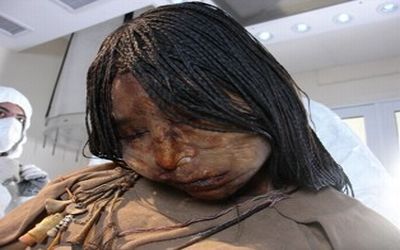Scientists Detect Immune Response of a 500-Year-Old Mummy


The 500-year-old mummy known as The Maiden.
A team of scientists that used a method of analyzing proteins from samples is the first to detect an immune response from a 500-year-old Incan mummy. Completed at the Proteomics Center, Stony Brook University, the process led to the first positive evidence of active pathogenic infection in an ancient sample of a 15-year-old girl who exhibited an immune response consistent with chronic respiratory infection. Their findings are reported in the PLoS One article Detecting the Immune System Response of a 500 Year-old Inca Mummy.
Â
Pathogen detection in human remains, including ancient ones, can help uncover mysteries of past diseases and epidemics and in determining cause of death. Techniques have been largely based on amplification of DNA from microbes. This process is effective for confirming the presence of a pathogen but not for determining if a person was ill with an infectious disease. Angelique Corthals, PhD, a forensic anthropologist at John Jay College of Criminal Justice, who will join the Department of Pathology, Stony Brook University School of Medicine, as assistant professor (as of September 1), and her colleagues at Stony Brook University, discovered a way to work around the problem by using a method that systematically profiles and quantifies all the proteins in a sample and does not require fresh tissue.
Â
The technique enabled us to determine that an infectious agent was active in one of the mummies that we examined, says Corthals. This approach opens a new door to ways in which scientists can more accurately solve some of historys pressing medical mysteries, such as why the influenza epidemic of 1918 was so devastating, or what really caused such high mortality in Plague epidemics.
Corthals explained that when a pathogen strikes, the body defends itself by producing a distinct profile of proteins. The most common immunoassay technique that is designed to bind immune system proteins (called antigens), and identify their patterns, is prone to contamination in ancient tissues and requires knowing in advance what kind of pathogen struck the patient. Therefore, Corthals needed another way to determine the protein profiles directly from archeological specimens.
Â
The team took swabs from the lips of two Andean Inca mummies that were buried in the Andean mountains and preserved when found in 1999. The bodies are currently preserved at the Museum of High Altitude Archeology in Salta, Argentina. After processing the swab samples to separate DNA and proteins, the researchers detected proteins using a high-resolution mass spectrometer and analyzed the sequenced proteins by comparing collected mass spectra to the human protein database.
Â
The key finding resulted from the swab sample of the mummy of a 15-year-old girl, called The Maiden. The protein profile from the sample mirrored the ones presented by chronic respiratory patients. Specifically, two groups of protein patterns were consistent with severe inflammation of the lungs.
Â
The swab from the Maiden was further analyzed by amplifying fragments of its DNA in the laboratory of Liliana Dávalos, PhD, assistant professor in the Department of Ecology and Evolution, and member of the Consortium for Inter-Disciplinary Environmental Research (CIDER), Stony Brook University. This analysis revealed the presence of probable pathogenic bacteria in the genus Mycobacterium, pathogens that cause upper respiratory tract infections and tuberculosis.
Â
In addition, computed tomography (CT) scanning, along with visual and radiologic examinations of the Maiden, also revealed pathologies consistent with a wide range of infectious diseases. The examinations showed inflammation on her upper right lung and mucosal enlargement in her sinus cavity.
Â
The mass spectrometry-based proteomic application is a powerful complement to forensic DNA analyses and other examinations that point to pathogens, says Dávalos. Completing each of these analyses and tests helps determine what infectious agent caused disease and the extent of active infection in the host.
Â
The research team identified three distinct advantages that proteomics has over other methods in archeological and forensic research. First, proteins can outlast DNA by thousands to millions of years, enabling scientists to seek answers to disease and immunity much further back in time. Second, protein detection does not rely on amplification, so it is less susceptible to in-lab contamination. Third, a broad spectrum of proteins can be characterized from small samples, which results in a more resolved picture of immune response than from immunoassays.
Â
Corthals and Dávaloss study co-authors include: Antonius Koller, Dwight W. Martin, Robert Rieger, and Emily I. Chen, of the Proteomics Center, Stony Brook University; and Mario Bernaski and Gabriella Recagno of the Museo de Arqueologia de Alta Montana in Salta, Argentina.
Â
The research was supported in part by the National Institutes of Health, the National Geographic Society, and the Secretariat of Culture of the Province of Salta, Argentina.
From the Derby to the Decontam Room: Leadership Lessons for Sterile Processing
April 27th 2025Elizabeth (Betty) Casey, MSN, RN, CNOR, CRCST, CHL, is the SVP of Operations and Chief Nursing Officer at Surgical Solutions in Overland, Kansas. This SPD leader reframes preparation, unpredictability, and teamwork by comparing surgical services to the Kentucky Derby to reenergize sterile processing professionals and inspire systemic change.
Show, Tell, Teach: Elevating EVS Training Through Cognitive Science and Performance Coaching
April 25th 2025Training EVS workers for hygiene excellence demands more than manuals—it requires active engagement, motor skills coaching, and teach-back techniques to reduce HAIs and improve patient outcomes.
The Rise of Disposable Products in Health Care Cleaning and Linens
April 25th 2025Health care-associated infections are driving a shift toward disposable microfiber cloths, mop pads, and curtains—offering infection prevention, regulatory compliance, and operational efficiency in one-time-use solutions.
Phage Therapy’s Future: Tackling Antimicrobial Resistance With Precision Viruses
April 24th 2025Bacteriophage therapy presents a promising alternative to antibiotics, especially as antimicrobial resistance continues to increase. Dr. Ran Nir-Paz discusses its potential, challenges, and future applications in this technology.